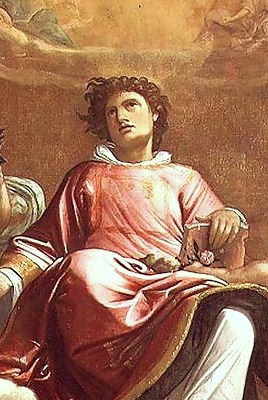Giacomo Cavedone
Italian painter (1577–1660) From Wikipedia, the free encyclopedia
Giacomo Cavedone (also called Giacomo Cavedoni; 1577–1660) was an Italian Baroque painter of the Bolognese School.

Life
Summarize
Perspective
He belonged to the generation of Carracci-inspired or trained painters that included Giovanni Andrea Donducci (Mastelletta); Alessandro Tiarini, Lucio Massari, Leonello Spada and Lorenzo Garbieri. He was born in Sassuolo, near Modena, and was able to obtain a three-year stipend to apprentice with Bernardino Baldi and Annibale Carracci. [1] In the autumn of 1609, he sojourned in Rome for a year to work under Guido Reni, and is known to have worked in Venice from 1612 to 1613. He became one of Ludovico Carracci's primary assistants, and upon Ludovico's death in 1619 became Caposindaco of the Accademia degli Incamminati.
His career as a painter was cut short by a set of misfortunes; these included a 1623 fall from a church scaffold and, in 1630, the death of his wife and children from the plague. The 1911 Britannica (where he is incorrectly called Jacopo Cavendone) claims his wife was accused of witchcraft.[1] He lived until 1660, and died in poverty.

His principal works are the Adoration of the Magi,[2] the Four Doctors, Last Supper; and his masterpiece, the large altar painting in the Pinacoteca Nazionale di Bologna, Virgin and Child in Glory with Saints Petronio and Alo (1614).[3] This painting was originally made for the chapel of the guild of metal-workers in church of the Mendicanti. While this painting has a traditional Ludovico Carracci-inspired structure, with a Madonna and her wafting robes hovering above donors, it also has an unusually rich Titianesque coloring for an Emilian painter.[4] Among his pupils were Giovanni Andrea Sirani, Giovanni Battista Cavazza, Ottavio Corradi, and Flaminio Torre.[5]
Partial anthology
- Saint Stephen in Glory, (1601, Galleria Estense, Modena)
- Deposition, (Santuario di Caravaggio)
- Death of Saint Peter Martyr, (Pinacoteca Nazionale, Bologna)
- Baptism of Christ, (1611–12, San Pietro Martire, Modena)
- Virgin and Child with Saints Petronio and Alo, (1614, Pinacoteca Nazionale, Bologna)
- Discovery of Miraculous Crucifix of Beirut, (1622, San Salvatore, Bologna)
- Adoration of the Shepherds and Adoration of the Magi, (San Paolo Maggiore, Bologna)
- Seated Warrior Holding a Sword and Shield, (drawing, c. 1612, National Gallery of Art)
- Sketch for The Last Supper; verso: The Conversion of St. Paul, Fogg Art Museum)
- The Miracle of the Loaves and Fishes (drawing, 1611–1614, Fitzwilliam Museum, Cambridge)
- Judith of Holofernes & Complaint of Job
References
Sources
Wikiwand - on
Seamless Wikipedia browsing. On steroids.
